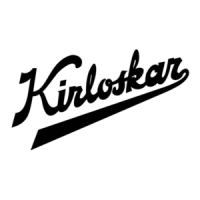Do you have a question about the KIRLOSKAR UP 250/38 and is the answer not in the manual?
Explains how pump model numbers are structured, e.g., UP 100/35.
Covers general safety awareness, nameplate importance, access control, and training.
Guidelines for safe handling, transport, and storage of the pump to prevent damage.
Visual inspection procedures for pump damage upon receipt.
Steps for cleaning pump flanges and removing protective coatings before installation.
Guidance on selecting an optimal pump location to ensure efficient suction and accessibility.
Requirements for a stable and rigid foundation to absorb vibrations and support the base plate.
Leveling and securing the baseplate using shims and tightening foundation bolts.
Steps for grouting the baseplate to ensure stability and prevent shifting.
Methods for checking and adjusting pump and driver shaft alignment.
Best practices for installing piping to minimize friction and avoid strain on the pump.
Essential pre-startup checks and procedures, including alignment and priming.
Steps for safely starting the pump and operating discharge valves.
Routine checks during pump operation, monitoring bearings and stuffing box.
Procedures for safely shutting down the pump and its driver.
Details on standard and optional pump rotation directions.
Specific bearing models and SKF reference numbers for various pump types.
Guidelines for bearing maintenance, cleaning, and lubrication.
Information on initial bearing lubrication and recommended re-greasing intervals.
Specifications for diametrical clearances between impeller and casing wear rings.
Identification of pump types fitted with single or double entry impellers.
Instructions for packing installation, adjustment, and replacement for stuffing boxes.
Information on standard and available coupling types for pump sets.
Critical importance of maintaining minimum flow to prevent pump damage.
Requirements for Net Positive Suction Head to avoid cavitation.
Recommended suction/delivery pipe velocities for efficient operation.
Sizes of pump tapping points (e.g., vent, priming).
Maximum forces and moments permitted on pump flanges for safe operation.
Nominal bore sizes for suction and delivery flanges for each pump type.
Table listing max speeds and water fill capacities for pump models.
Graph showing starting torque requirements under different operating conditions.
Approximate weights and GD^2 values for various pump models.
Table detailing which parts are interchangeable across different pump models.
Safety guidelines for maintenance, covering hazards and necessary precautions.
Detailed steps for safely taking apart the pump for overhaul.
Detailed steps for reassembling the pump after overhaul.
Explains how pump model numbers are structured, e.g., UP 100/35.
Covers general safety awareness, nameplate importance, access control, and training.
Guidelines for safe handling, transport, and storage of the pump to prevent damage.
Visual inspection procedures for pump damage upon receipt.
Steps for cleaning pump flanges and removing protective coatings before installation.
Guidance on selecting an optimal pump location to ensure efficient suction and accessibility.
Requirements for a stable and rigid foundation to absorb vibrations and support the base plate.
Leveling and securing the baseplate using shims and tightening foundation bolts.
Steps for grouting the baseplate to ensure stability and prevent shifting.
Methods for checking and adjusting pump and driver shaft alignment.
Best practices for installing piping to minimize friction and avoid strain on the pump.
Essential pre-startup checks and procedures, including alignment and priming.
Steps for safely starting the pump and operating discharge valves.
Routine checks during pump operation, monitoring bearings and stuffing box.
Procedures for safely shutting down the pump and its driver.
Details on standard and optional pump rotation directions.
Specific bearing models and SKF reference numbers for various pump types.
Guidelines for bearing maintenance, cleaning, and lubrication.
Information on initial bearing lubrication and recommended re-greasing intervals.
Specifications for diametrical clearances between impeller and casing wear rings.
Identification of pump types fitted with single or double entry impellers.
Instructions for packing installation, adjustment, and replacement for stuffing boxes.
Information on standard and available coupling types for pump sets.
Critical importance of maintaining minimum flow to prevent pump damage.
Requirements for Net Positive Suction Head to avoid cavitation.
Recommended suction/delivery pipe velocities for efficient operation.
Sizes of pump tapping points (e.g., vent, priming).
Maximum forces and moments permitted on pump flanges for safe operation.
Nominal bore sizes for suction and delivery flanges for each pump type.
Table listing max speeds and water fill capacities for pump models.
Graph showing starting torque requirements under different operating conditions.
Approximate weights and GD^2 values for various pump models.
Table detailing which parts are interchangeable across different pump models.
Safety guidelines for maintenance, covering hazards and necessary precautions.
Detailed steps for safely taking apart the pump for overhaul.
Detailed steps for reassembling the pump after overhaul.
| Model | UP 250/38 |
|---|---|
| Category | Power Pump |
| Flow Rate | 250 m³/hr |
| Head | 38 m |
| Voltage | 415 V |
| Speed | 1450 rpm |
| Phase | 3 |











